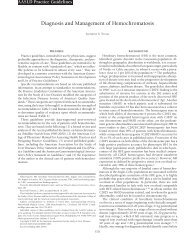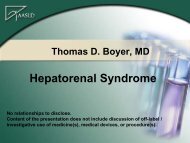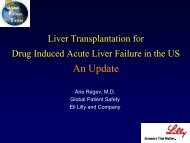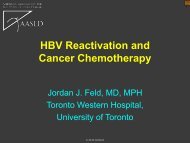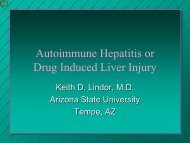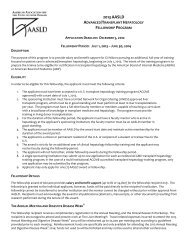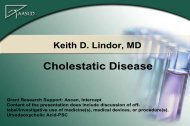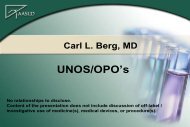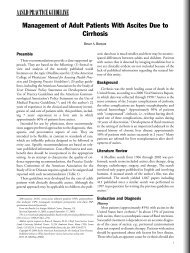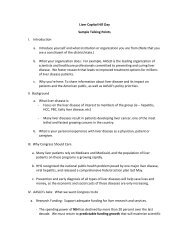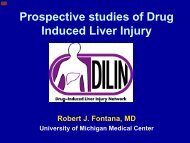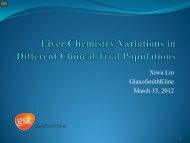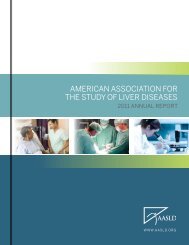Pediatric DILI in the United States: Preliminary DILIN ... - AASLD
Pediatric DILI in the United States: Preliminary DILIN ... - AASLD
Pediatric DILI in the United States: Preliminary DILIN ... - AASLD
Create successful ePaper yourself
Turn your PDF publications into a flip-book with our unique Google optimized e-Paper software.
<strong>Pediatric</strong> <strong>DILI</strong> <strong>in</strong> <strong>the</strong> <strong>United</strong> <strong>States</strong>:Prelim<strong>in</strong>ary <strong>DILI</strong>N ExperienceNaga Chalasani, MD, FACGProfessor and DirectorDivision of Gastroenterology and HepatologyIndiana University School of Medic<strong>in</strong>eFDA-<strong>AASLD</strong>-PHARMA <strong>DILI</strong> Conference: March 2010
Vignette # 1• One-year old baby referred for enroll<strong>in</strong>g <strong>in</strong>to<strong>the</strong> <strong>DILI</strong>N Prospective Study• Born with complex congenital heart disease <strong>in</strong>2005 (TOF)• Blalock-Taussig procedure done on 2 nd day• One year later, she had a def<strong>in</strong>itive procedureperformed to correct <strong>the</strong> TOF• Had pseudomonal UTI and receivedpiperacill<strong>in</strong> and gentamyc<strong>in</strong> for 9 days
Vignette # 1• Trip to ER for fever and URI symptoms• Prescribed amoxicill<strong>in</strong>• Rash a day later with ery<strong>the</strong>ma and blisters on<strong>the</strong> face and <strong>the</strong>n to rest of her body• One week later, she developed jaundice• Bilirub<strong>in</strong> 8.3 mg/dl, AST 1355, ALT 907, Alk P 512U/L• Hep A/B/C, ANA/ASMA, liver us with doppler,blood cultures negative
Vignette # 1• Sk<strong>in</strong> biopsy showed changes c/w toxicepidermal necrolysis• Liver failure ensued with multiple organ failureand subsequent death• Postmortem showed massive loss ofhepatocytes with negligible <strong>in</strong>flammation
Vignette # 2• 12-yr old girl was evaluated for acute hepatitis• One week before she developed nausea,diarrhea, and jaundice• She was restarted on atomoxet<strong>in</strong>e (40 mg/d)three weeks prior to admission• Received atomoxet<strong>in</strong>e for one year but<strong>in</strong>terrupted for 6-weeks due to prescriptionlapse
Vignette # 2• No history of liver disease, exposure tohepatitis or known hepatotox<strong>in</strong>s• AST 2999, ALT 3264, Alk P 231, TB 9.1 mg/dl• Hep A/B/C/EBV/CMV negative• ANA 1:160 but ASMA, LKM negative• Ceruloplasm<strong>in</strong> negative• Ultrasound showed mild fatty <strong>in</strong>filtration
LIVER BIOPSYLiver biopsy showed <strong>in</strong>tact hepatic architecture withfocal th<strong>in</strong> bridg<strong>in</strong>g fibrosis. Portal areas showedmoderate mixed <strong>in</strong>flammatory <strong>in</strong>filtrates,predom<strong>in</strong>antly lymphocytes, eos<strong>in</strong>ophils.
<strong>Pediatric</strong> <strong>DILI</strong>• Rare cause of acute and chronic liver disease<strong>in</strong> children• Can cause asymptomatic elevations <strong>in</strong> livertests, chronic liver disease, and ALF• Acetam<strong>in</strong>ophen toxicity result<strong>in</strong>g <strong>in</strong> ALF is wellknown• Data are sparse <strong>in</strong> terms of cl<strong>in</strong>icalcharacteristics and outcomes
Peds <strong>DILI</strong>: ALF• In a multicenter study of 348 children with ALF<strong>in</strong> <strong>the</strong> US, acetam<strong>in</strong>ophen toxicity <strong>in</strong> 48children (14%)• Idiosyncratic <strong>DILI</strong> <strong>in</strong> 17 patients (5%)• Valproate (3), INH (2), mushroom (2), and oneeach of anes<strong>the</strong>tic, bactrim, cytoxan/dilant<strong>in</strong>,dilant<strong>in</strong>, Iron, m<strong>in</strong>ocycl<strong>in</strong>e, pravastat<strong>in</strong>, cylert,methotrexateSquires Jr RH et al. Journal of <strong>Pediatric</strong>s 2006;148:652-658
Peds <strong>DILI</strong>: Outcomes of ALFDead Alive TransplantedIdiosyncratic (n=17) 5 7 5Acetam<strong>in</strong>ophen (n=48) 2 45 2Squires Jr RH et al. Journal of <strong>Pediatric</strong>s 2006;148:652-658
Peds <strong>DILI</strong> <strong>in</strong> <strong>the</strong> literature• Antibiotics, INH, Psychoactive drugs, andm<strong>in</strong>ocycl<strong>in</strong>e are <strong>the</strong> usual suspects <strong>in</strong> children• Children may be differentially susceptible to<strong>DILI</strong> caused by valproate, aspir<strong>in</strong>, and may beresistant to usual suspects such asamox/clavulanate
<strong>DILI</strong>N Prospective Study• Multicenter study at 8 academic centers• Children > 2 years are eligible• >25% likelihood of <strong>DILI</strong>• Detailed work-up at basel<strong>in</strong>e• Standardized causality and severityadjudication• Follow-up duration of 6 – 24 monthsFontana RJ et al. Drug Safety 2009
<strong>DILI</strong>N Prospective Study: Initial 300• 93% adultspatients• S<strong>in</strong>gle prescription agent <strong>in</strong> 73% and CAM <strong>in</strong>9%• Antimicrobials (45.5%) and CNS agents (15%)• Chronic <strong>DILI</strong> <strong>in</strong> 14%• Death <strong>in</strong> 8%, but it was liver-related <strong>in</strong> 44%• Acute Hep C was an unsuspected culprit <strong>in</strong> 4casesChalasani N et al. Gastroenterology 2008
Peds <strong>DILI</strong>: <strong>DILI</strong>N Data• Data from 9/04 through 9/09• Out of 611 consecutively enrolled subjects, 30were children (>18 years of age)• AST or ALT > 5 ULN, two consecutive read<strong>in</strong>gsor TB > 2.5 mg/dl or Alk P > 2 ULN or INR > 1.5along with elevated AST, ALT, Alk P• APAP toxicity is exclusionary• No obvious compet<strong>in</strong>g etiologies atenrollment
Peds <strong>DILI</strong>: <strong>DILI</strong>N Data• Mean and median ages were 12.3 and 13.7 yrs• 70% female• Prior drug allergy <strong>in</strong> 43%• Alcohol abuse was rare• One child with biliary atresia, but underly<strong>in</strong>gneuropsychiatric, pulmonary or cardiac comorbiditieswere common
Peds <strong>DILI</strong>: <strong>DILI</strong>N Data• Median latency for symptoms was 31 days andfor <strong>DILI</strong> identification was 46 days• Common symptoms: jaundice, abdom<strong>in</strong>alpa<strong>in</strong>, pruritus, nausea, rash, fever• S-J syndrome <strong>in</strong> 2 patients• 78% hepatocellular, 13% cholestatic and 9%mixed [Adults: HC -57%, CS – 23%, and Mixed20%]
<strong>DILI</strong>N Peds <strong>DILI</strong> DataCl<strong>in</strong>ical Presentation Median (25-75 th )Duration <strong>in</strong> daysDays from drug start to symptomsDays from drug start to <strong>DILI</strong>N startDays from onset to peak bilirub<strong>in</strong>Days from onset to peak ALTDays from onset to TB
Peds <strong>DILI</strong>: <strong>DILI</strong>N DataPeak Biochemical ValuesALT (U/L)AST(U/L)Alkal<strong>in</strong>e Phosphatase(U/L)Total Bilirub<strong>in</strong> (mg/dL)INRANA PositiveAnti-SMA PositiveIgG Mean (Median) (mg/dl)Absolute Eos<strong>in</strong>ophils (mm 3 )Mean values1032 ± 976915 ± 908383 ± 2719.4 ±111.7 ±1.4746%42%1873 ±1942196 ±194
<strong>DILI</strong>N Peds <strong>DILI</strong>: Implicated agentsAntimicrobials (n=15) CNS agents (n=13) O<strong>the</strong>rs (8)M<strong>in</strong>ocycl<strong>in</strong>e (4)INH (N=3)Azithromyc<strong>in</strong> (3)Amoxicill<strong>in</strong> (2)Oxacill<strong>in</strong> (1)Levofloxac<strong>in</strong>(1)TMP/SMX(1)Atoxomet<strong>in</strong>e (3)Lamotrig<strong>in</strong>e (3)Valproate (2)Phenobarbital (1)Phenyto<strong>in</strong>(1)Fluoxet<strong>in</strong>e (1)Amitriptyl<strong>in</strong>e (1)Methylphenidate (1)Hydroxycut (1)Nicot<strong>in</strong>amide (2)Daunorubic<strong>in</strong> (1)V<strong>in</strong>crist<strong>in</strong>e (1)MethylDopa (1)Yasm<strong>in</strong> (1)Carbamazep<strong>in</strong>e/perphenaz<strong>in</strong>e (1)
Causality Scores<strong>DILI</strong>N ScoreDef<strong>in</strong>iteVery LikelyProbablePossiblyUnlikelyRUCAM ScoreHighly probableProbablePossibleUnlikelyExcluded39%35%13%9%4%12.5%46%29%8%4%
<strong>DILI</strong>N Severity ScoresCategory Proportion (%)MildModerateModerate / HospitalizedSevereFatal302222224
Liver Histology (n=10)Inflammation: Cells Plasma cells 1/10<strong>in</strong>creasedEos<strong>in</strong>ophils 5/10Neutrophils 2/10Inflammation: Pattern Interface hepatitis Grade 3 or 4 5/10Lobular hepatitis Grade 3 or 4 5/10Portal hepatitis Grade 3 or 4 1/10Bile duct <strong>in</strong>jury Present 3/10Fibrosis Grade 3 or 4 (none 5, 6) 5/9Overall Pattern Acute hepatitis 1/10Chronic hepatitis 4/10Acute cholestasis 2/10Comb<strong>in</strong>ed hepatitis/cholestasis 2/10
Peds <strong>DILI</strong>: OutcomesHospitalized 63%Death 4.5%Liver Transplant 0Chronic <strong>DILI</strong> 6.7%Received steroids 52%
Summary• <strong>Pediatric</strong> <strong>DILI</strong> accounts for 5-7% of <strong>the</strong> <strong>DILI</strong>cases <strong>in</strong> <strong>the</strong> <strong>DILI</strong>N Prospective Study• Antimicrobials and CNS agents are <strong>the</strong> mostcommon classes implicated• CAM <strong>DILI</strong> is rare• Autoimmune <strong>DILI</strong> is common• Fatality rate 5%
Acknowledgements• <strong>DILI</strong>N Co-<strong>in</strong>vestigators• NIDDK• Nurs<strong>in</strong>g staff• Research participants



